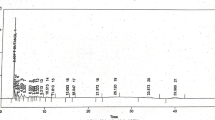Abstract
Phenolic compounds of fruits have been shown to maintain human health. However, the relative amounts of phenolic compounds and the variation in the types of phenolics are still poorly understood. The purpose of this study was to investigate the most effective solvent for extracting the potent antioxidant compounds, especially phenolics from pomegranate aril. Pomegranate aril was subjected to extraction using different solvents viz., water, ethanol, acetone and diethyl ether either alone or in combination, and the extraction yield, total phenolic contents, and antioxidant activity were investigated. The extracts derived from various solvents were also analysed using high performance liquid chromatography (HPLC) for quantification of major polyphenols (punicalagins, ellagic acid and gallic acid) of pomegranate. Amongst the tested solvents, combination of ethanol, diethyl ether and water (8:1:1) extract exhibited the highest 2, 2-diphenyl-1-picrylhydrazyl (DPPH) radical scavenging power (IC50 = 10.12 μg mL-1). Further, HPLC analysis of different extracts revealed that ethanol, diethyl ether and water (8:1:1) mixture contained significantly higher (p < 0.05) amounts of punicalagin A (1.06 μg mg-1 extract), punicalagin B (2.07 ± 0.03 μg mg-1 extract), ellagic acid (34.5 μg mg-1 extract) and gallic acid (3.37 μg mg-1 extract) in comparison to the other solvents used for extraction. The results demonstrate that pomegranate aril is a good source of phenolic compounds with high antioxidant activity and the antioxidant activity is dependent on the type of solvent system that extracts different phenolic compounds with varying polarity. The solvent extracts that showed effective antioxidants activities have the potential for application in suitable food products.





Similar content being viewed by others
References
Akowuah GA, Ismail Z, Norhayati I, Sadikun A (2005) The effects of different extraction solvents of varying polarities on polyphenols of Orthosiphon stamineus and evaluation of the free radical-scavenging activity. Food Chem 93:311–317
Barros L, Falcao S, Baptista P, Freire C, Vilas-Boas M, Ferreira ICFR (2008) Antioxidant activity of Agaricus sp. mushrooms by chemical, biochemical and electrochemical assays. Food Chem 111:61–66
Ҫama M, Hișil Y (2011) Pressurised water extraction of polyphenols from pomegranate peels. Food Chem 123:878–885
Chang ST, Wu JH, Wang SY, Kang PL, Yang NS, Shyur LF (2001) Antioxidant activity of extracts from Acacia confusa bark and heartwood. J Agric Food Chem 49:3420–3424
Gil MI, Tomas-Barberan FA, Hess-Pierce B, Holcroft DM, Kader AA (2000) Antioxidant activity of pomegranate juice and its relationship with phenolic composition and processing. J Agric Food Chem 48:4581–4589
Hagerman AE, Riedl KM, Jones GA, Sovik KN, Ritchard NT, Hartzfeld PW (1998) High molecular weight plant polyphenolics (tannins) as biological antioxidants. J Agric Food Chem 46:1887–1892
Julie Jurenka MT (2008) Therapeutic applications of pomegranate (Punica granatum L.): a review. Altern Med Rev 13:128–144
Kulkarni AP, Aradhya SM (2005) Chemical changes and antioxidant activity in pomegranate arils during fruit development. Food Chem 93:319–324
Mertens-Talcott SU, Jilma-Stohlawetz P, Rios J, Hingorani L, Derendorf H (2006) Absorption, metabolism and antioxidant effects of pomegranate (Punica granatum L.). Polyphenols after ingestion of a standardized extract in healthy human volunteers. J Agric Food Chem 54:8956–8961
Mousavinejad G, Emam-Djomeh Z, Rezaei K, Khodaparast MHH (2009) Identification and quantification of phenolic compounds and their effects on antioxidant activity in pomegranate juices of eight Iranian cultivars. Food Chem 115:1274–1278
Panichayupakaranant P, Tewtrakul S, Yuenyongsawad S (2010) Antibacterial, anti-inflammatory and anti-allergic activities of standardised pomegranate rind extract. Food Chem 123:400–403
Perez-Vicente A, Izquierdo A, Garcia-Viguera C (2002) In vitro gastrointestinal digestion study of pomegranate juice phenolic compounds, anthocyanins and vitamin c. J Agric Food Chem 50:2308–2312
Qua W, Pan Z, Ma H (2010) Extraction modeling and activities of antioxidants from pomegranate marc. J Food Eng 99:16–23
Qua W, Breksa AP, Pan Z, Ma H (2012) Quantitative determination of major polyphenol constituents in pomegranate products. Food Chem 132:1585–1591
Re R, Pellegrini N, Proteggente A, Pannala A, Yang M, Rice-Evans C (1999) Antioxidant activity applying an improved ABTS radical cation decolorization assay. Free Radic Biol Med 26:1231–1237
Seeram NP, Adams LS, Henning SM, Niu Y, Zhang Y, Nair MG, Heber D (2005) In vitro antiproliferative, apoptotic and antioxidant activities of punicalagin, ellagic acid and a total pomegranate tannin extract are enhanced in combination with other polyphenols as found in pomegranate juice. J Nutr Biochem 16:360–367
Turkmen N, Sari F, Polat G, Velioglu YS (2006) Effects of extraction solvents on concentration and antioxidant activity of black and mate tea polyphenols determined by ferrous tartrate and Folin-Ciocalteu methods. Food Chem 99:835–841
Yu YM, Chang WC, Wu CH, Chiang SY (2005) Reduction of oxidative stress and apoptosis in hyperlipidemic rabbits by ellagic acid. J Nutr Biochem 16:675–681
Zhang L, Fu Q, Zhang Y (2011) Composition of anthocyanins in pomegranate flowers and their antioxidant activity. Food Chem 127:1444–1449
Zielinski H, Kozłowska H (2000) Antioxidant activity and total phenolics in selected cereal grains and their different morphological fractions. J Agric Food Chem 48:2008–2016
Author information
Authors and Affiliations
Corresponding author
Rights and permissions
About this article
Cite this article
Singh, M., Jha, A., Kumar, A. et al. Influence of the solvents on the extraction of major phenolic compounds (punicalagin, ellagic acid and gallic acid) and their antioxidant activities in pomegranate aril. J Food Sci Technol 51, 2070–2077 (2014). https://doi.org/10.1007/s13197-014-1267-0
Revised:
Accepted:
Published:
Issue Date:
DOI: https://doi.org/10.1007/s13197-014-1267-0




